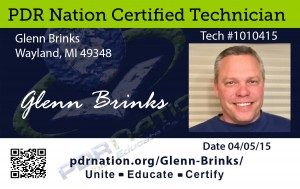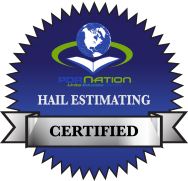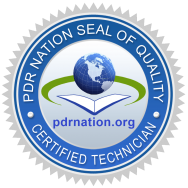General Guidelines for Professional Hail Estimation
Hail Damage Repairs near Kalamazoo, MI
You the owner of your vehicle choose who repairs your vehicle, not the insurance company. If your vehicle has been damaged in a hail storm, contact Dent Tec first. We will be happy to guide you through the process of restoring your vehicle to pre-storm condition.
It’s important to use a reputable technician so your vehicle is repaired correctly the first time. Not all technicians repar hail damage to the same quality – some leaving unfinished dents drilled holes, and cracked paint which will cause you problems down the road. Dent Tec has technicians who are highly experienced at performing high-quality repairs. Below are some guidlines and factors to determine the best possible repairs to your vehicle.




General Guidelines
VEHICLE CONDITION:
Estimate should be completed on a cleaned vehicle, indoors, and using professional PDR lighting equipment.
SPECIAL CAUTIONS:
Details of this guide are subject to the specifics of each situation. It is understood that no two dents, storms, or technicians are alike and should be evaluated on an individual basis. This includes but is not limited to variance in repair location, damage specific to each storm, previous damage to the location of current repair, and more. All claims should be assessed individually.
ESTIMATING EXPLANATION:
The necessities of the following procedures should be left to the discretion of the servicing PDR technician. The noted procedures may be needed to gain access to any damaged areas for the dent removal process to begin. Proper R&I techniques shall be used according to manufacturer’s specs. It is understood that the listed items below do not include: Dent removal, cleaning or preparing the panel, or circling/highlighting the damage for estimating purposes. The finish of the vehicle is of vital importance in consideration of PDR as a viable method of repair. To obtain the desired end result of a quality PDR repair, paint must be in good condition. Factors that may prohibit complete auto-body factory condition restoration include (but are not limited to):
- Matte finish
- Vehicle wraps
- Stripes, decals, transfers or overlays
- Aftermarket panels
- Non factory paint
- Damaged/checked paint
- Rock chips
- Panels with prior conventional repairs or repainted panels
- Previous damage unrelated to storm event
In high winds, some damage may be caused by storm debris such as broken branches from nearby trees, solid objects being carried by high winds, etc
DAMAGE ESTIMATION GUIDELINES
DETERMINING DENT SIZE:
When using the sizing coin/magnet, the edges of the dent must be inclusive of the size of the measured circles to be considered that specific size. If the edges of the dent damage exceed the size of the circle on the magnet, then the dent is counted as being the next size up and will not be estimated at the size down or smaller than the actual damage. The affected area is to be determined by the PDR Technician and may include surface area greater than that of the measured indentation.
DENTS/PANELS THAT SHOULD NOT BE SUBJECT TO STANDARD PRICING:
The following items can be added to an estimate and may incur additional repair costs. Additional items should not be limited to one per panel since each item independently adds to the time and difficulty of the repair. The vehicle and vehicle damage will be inspected to determine access and repair technique/difficulty. Items that may result in a longer, and/or more difficult repair and may incur additional repair costs include but are not limited to:
- Tall Vehicles
Vehicle panels that require a technician to use the assistance of a bench/ladder in order to gain access to perform the repair.
Panels with Laminated Glass
Laminated glass is especially susceptible to damage. Special caution must be taken in order to properly perform a repair on panels containing laminated glass.
Extended Roof
Extra time and advanced techniques/tools can be required to properly repair an extended roof.
Glue Pulling
Glue pulling a dent(s) takes significantly longer to repair than the standard repair method. Some panels require the glue pulling method in order to be repaired properly.
Double Panels/Heavily Braced Panels
This should not be limited to roof rails, doors, and deck lids. This includes areas that are not typically involved in the discussion of double paneled areas. Front of hoods, tops of doors, door area underneath belt molding, quarter panels at front, and deck lids are often heavily braced. A panel is considered a heavily braced / and or a double panel when there is little to no direct access to the damaged area.
High Strength Steel (HSS) and Ultra High Strength Steel (UHSS)
HSS/UHSS have a higher Tensile Strength (MPa), resulting in a more challenging and time consuming repair.
Aluminum
Aluminum has less metal memory, resulting in a more challenging and time consuming repair.
Extra Thin Metal
Extra thin metal results in a more challenging and time consuming repair.
Panels with Sound Deadening
Sound deadening creates a barrier between the technician’s tool and the damage, resulting in a more challenging and time consuming repair.
Poor Access
Extra/tight bracing and lack of factory access holes can create poor access.
Extra Large Panel
Unusually large panels can create leverage problems, access difficulty and require extra time and advanced techniques.
Ribbed Roof
A ribbed roof results in having to repair dents on concave and convex surfaces. Dents that are not on flat surfaces result in a more challenging and time consuming repair.
Deep Dents
Dent depth can be assessed visually by qualified technicians, or measured in mm using a depth gauge.
Over-Sized Dents
See section titled “DETERMINING DENT SIZE”. With minute increases in size of the damage the difficulty of repair increases exponentially. Half dollar, Egg, Tennis ball, Baseball, Softball, and Grapefruit; should all be evaluated as their own respective categories
Sharp Dents
The ratio between dent size and dent depth (determined by the technician), as well as metal type, may result in a sharp dents which require special technique and result in a more challenging and time consuming repair.
Multiple connected dents or one or more dents that fall in the affected area of another dent
- Stretched dents
- Corner or edge dents
- Dents on tight radius, extra stiff curves
- Creases
- Materials
- Shop supplies, tool tips, glue supplies, solvents, tape, compounds, etc.
- Corrosion Protection
Refinishing/sealing undersides of painted panels where soft tipping is not an option
REMOVAL AND INSTALL GUIDELINES
REMOVAL AND INSTALL (R&I) LABOR TIMES
R&I labor times should be used to estimate time needed to remove and replace portions of the vehicle that cause obstruction to access points needed to repair damage. These items will vary depending on size/depth/location of the dents, vehicle age and condition, technician’s experience, equipment, vehicle make/model, etc. Labor rates default by regional location.
GENERAL/MISC REMOVAL AND INSTALL (R&I) PROCEDURES:
R&I of any obstruction to enable visibility of repair area, on any vehicle, deemed necessary by the repairing technician, in order to gain access and/or leverage on the backside of the damaged area.
- Lifting of the vehicle when needed to see, gain access, or perform the repair
- Preparation of vehicle including but not limited to: removal of dirt/snow/ice, etc.
- Light buffing if needed to see the damage and repair it correctly
- R&I of aftermarket items
- Areas of vehicle paneling with ribbon sealer
- PCM/BCM reset, ABS, taillights, window memory and power liftgate, etc.
- R&R pinstripe, vinyl decals, stripes, clear bra
- Paint sealer, wax application/removal
- Sound deadening, panel stiffening
- Panel to bracing glue
- Weatherstrip clips
GLASS R&I PROCEDURES:
Back glass on trucks should be considered for removal if any of the following criteria is met:
- Glass is a single pane
- Sliding glass window does not provide adequate access for a complete and proper repair
- Vehicle has a ribbed roof
Quarter glass on SUVs and coupes should be considered for removal if technician deems it necessary for a complete and proper repair.
HOOD R&I PROCEDURES:
- Hood insulator pad
- Removing and securing the panel in a workable position
- Replacing the panel to original position on vehicle upon completion of repair
- Hood scoops
- Air deflector, bug guard
- Clear bra
- Grill
- Hood moldings,trim pieces, clips
- Washer nozzles
- Weatherstrip
FRONT FENDER R&I PROCEDURES:
- Fender liners
- Headlamps – Some vehicles require the front bumper to be removed to gain access to the headlamp anchor points for a full removal
- Grill
- Clear bra
- Plow frame
- Bumper guard
- Side marker light
- Air intake housing
- Windshield cowl
- Hood hinges
- Deflectors / trim pieces located in engine bay, inner fender
- Wheel flare
- Appearance grill
- Electronics
- Sound deadener
DOOR R&I PROCEDURES:
- Door panel
- Belt Moldings
- Vapor barrier
- Sound deadener
- Speaker
- Aftermarket window visor
- Mirror
- Exterior handle
- Striker catch
- Regulator assembly
- Weatherstrip
- Wire harness
- Door removal as needed
- Laminated glass window
- Side view mirror
QUARTER PANEL R&I PROCEDURES:
- Tail lights – Some vehicles require the rear bumper to be removed to gain access to the tail light anchor points for a full removal
- Interior trim
- Moldings
- Quarter glass
- Fuel door
- Computer modules
- Sound equipment
- Antenna motor
- Bumper
- Wheel
- Wheel opening trim / wheel flare
- Fuel door repair
BEDSIDE R&I PROCEDURES:
- Tail lamp
- Bed rail caps
- Camper shell, tonneau cover
- Rear wheel
- Wheel opening trim, flares
- Headache rack
- Toolbox
- Bumper
RAIL R&I PROCEDURES:
- Drip molding Supplies
- Glue materials
ROOF R&I PROCEDURES:
- Headliner R&I
- Overhead console
- Rear view mirror
- Roof mounted A/V equipment
- Liftgate/Hatch on SUV/Van/Crossover
- Airbags
- Roof racks
- Roof mounted antenna
- Roof mounted 3rd brake lamp
- Additional lamps
- Back glass on coupes, trucks
- Quarter panel glass
- Sunroof including tray when applicable
- Liftgate / rear hatch
- Windshield and or rear glass
- Restraint systems
- Exterior adhesive trim
- Drip moldings
- Sound deadener materials
DECK LID R&I PROCEDURES:
- Interior liner
- Removing and securing the panel in a workable position
- Replacing the panel to original position on vehicle upon completion of repair
- 3rd brake lamp
- Deck lid interior handle
- Additional panel mounted lamps
- Spoiler
- Wiring harness
- License plate trim piece
- Backup camera
SUV HATCH / LIFTGATE R&I PROCEDURES:
- Interior trim
- Removing and securing the panel in a workable position
- Replacing the panel to original position on vehicle upon completion of repair
- Liftgate mounted tire
- Spoiler
- Glass
- Moldings
- Panel mounted lamps
- License plate trim piece
- Wiring harness
- 3rd brake lamp
- Washer nozzles
- Washer hoses
- Wiper arm
- Weatherstrip
- Backup camera
TAILGATE R&I PROCEDURES:
- Trim panel
- Removing and securing the panel in a workable position
- Replacing the panel to original position on vehicle upon completion of repair
- Handle assembly
- Latch assembly
- Rail cap
- Ladder assembly/grab bar
- 3rd brake lamp
- Backup camera
